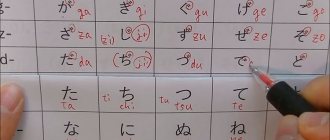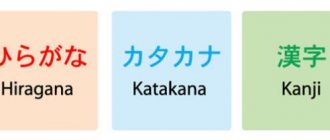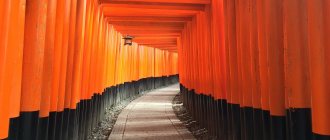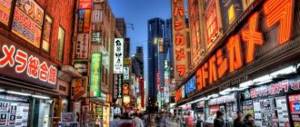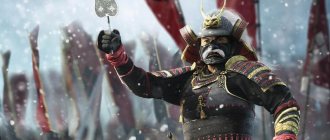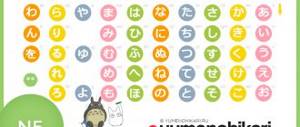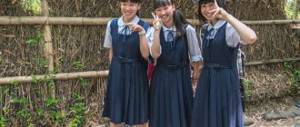Greetings, Friends. Igor Korotkov is with you. You are on the website Venasera.ru. Today we will talk about Japanese writing.
Traditionally, the Japanese language uses a vertical way of writing, i.e. The characters go from top to bottom and the columns go from right to left. This method continues to be widely used in fiction, as well as in newspapers. But in everyday life they usually use the standard, familiar to us, European way of writing , i.e. from left to right from top to bottom.
Writing in the Japanese language is divided into 2 Japanese syllabic alphabet Hiragana and Katakana , as well as kanji (hieroglyphs) .
ひらがな
Hiragana is used to write inflected parts of words, grammatical particles, or words whose hieroglyphic spelling has fallen out of use.
Hiragana characters are characterized by rounded, soft writing. Hiragana (平仮名) is translated from Japanese as “smooth alphabet” - that is, not “angular” like Katakana (片仮名). Hiragana was used by female authors of diaries and novels in the 9th to 12th centuries. Japanese poetry was written with it. Hiragana was a kind of “lightweight” letter, since it was believed that hieroglyphs for women were very difficult.
about how to easily and quickly remember the Hiragana alphabet in this video.
Hiragana
| a | i | u | e | o |
| あ | い | う | え | お |
| ka | ki | ku | ke | ko |
| か | き | く | け | こ |
| sa | shi | su | se | so |
| さ | し | す | せ | そ |
| ta | chi | tsu | te | to |
| た | ち | つ | て | と |
| na | ni | nu | ne | no |
| な | に | ぬ | ね | の |
| ha | hi | fu | he | ho |
| は | ひ | ふ | へ | ほ |
| ma | mi | mu | me | mo |
| ま | み | む | め | も |
| ya | yu | yo | ||
| や | ゆ | よ | ||
| ra | ri | ru | re | ro |
| ら | り | る | れ | ろ |
| wa | o | |||
| わ | を | |||
| n | ||||
| ん |
カタカナ
Another alphabet is katakana , used to write borrowed words from foreign languages. Those. Your name will also be written using the Katakana , because... it's foreign. Also, sometimes katakana is used to write the names of animals, plants, and also as a stylistic device to highlight the desired word.
Literally, Katakana (片仮名) is translated from Japanese as “angular alphabet.” Katakana characters are angular and sharp, in contrast to hiragana characters, which differ significantly in their smoothness. Compare! This is Hiragana and this is Katakana.
We talked about how to easily and quickly remember the Katakana alphabet in this video.
Katakana was invented by monks to rewrite Chinese texts, in particular Buddhist sutras, and just like Hiragana, it originated from Chinese characters, but not from whole characters (as was the case in Hiragana ), but from their parts. Unlike hieroglyphs the Hiragana and Katakana syllabaries convey only sound, without any meaning.
In order not to waste your time, we will not dwell in more detail on the origin of Japanese writing , but will move on to examples.
Why Japanese is special
Japan is one of the most amazing countries on our planet.
It is enough to read at least a couple of dozen facts about this country and you will understand why it is considered so unusual. Differences from the world we are used to are manifested in literally everything, for example, local children make snowmen from two circles, and not from three, as we are used to. Not surprisingly, the language here is also very unusual and is considered one of the most difficult to learn. Its main feature is already hidden in the alphabet. The thing is that the Japanese alphabet does not exist in a single copy. Yes, yes, there are two alphabets here. The two varieties of the alphabet, katakana and hiragana, are somewhat similar to each other, since they have a common structure, however, there are also significant differences between them.
The Japanese language is also notable for the fact that when writing, they use not only letters, but also hieroglyphs, which sometimes denote individual words or even entire phrases. All this confuses an unprepared person even more. As you can see, the local language is really difficult to learn, but this only makes it more interesting and extraordinary.
An example of using Japanese alphabets
Now some examples.
As we have already said, the changeable parts of a word are written in Hiragana: for example, there is a verb to look 見る (WORLD), the root of the hieroglyph (i.e. its unchangeable part) is written first -見 (MI) . It will be written in hieroglyphs. This word has a variable part - the ending る, which will change depending on the need, for example, if you need to convey the tense of the verb or the style of politeness. So 見るcan change to 見ます, 見ました, etc. Also, do not forget that grammatical particles in Japanese are also written in Hiragana , for example:私はイーゴリです。 “I am Igor.” In this case, the grammatical particle Ba and the copula Des will be written in Hiragana . My name is not Japanese, i.e. it is borrowed from the Russian language, so it is written in Katakana alphabet. I am Watashi is a Japanese word and it is written in Kanji, i.e. hieroglyph. As you may have noticed, Japanese writing consists of a combination of the Hiragana/Katakana alphabet and hieroglyphs .
Now some examples about Katakana alphabet . Japanese has quite a lot of borrowed words, such as Basu - bus, it is borrowed from English, so it is written in Katakana , the word Pan bread is borrowed from Portuguese, so it is also written in Katakana . Such words are called Gairaigo 外来語.
Now let's look at an example not related to borrowed words. The word “Cat” ( Neko) is written not only in hieroglyphs or Hiragana alphabet , but is also often written in Katakana alphabet - like this. This word is not borrowed, however, animals and plants can also be written in Katakana . And the names of plants are almost always written in katakana , because it’s not even difficult to imagine that it’s much easier to write ツツジ this way than 躑躅. In the post-war reforms, it was recommended to write in katakana , regardless of origin.
Most often, onomatopoeic words are written in Katakana, and figurative words in Hiragana, but this is not so important. 
But again, everything is individual, for example, in everyday life such words as Cat, Dog or Cow can often be found in hieroglyphs, and already such words as イノシシ, タコ or ツツジ, etc. Words are most often written in katakana.
I would like to note that when I talk about using Katakana (the theme with animals), do not take everything literally, because... there are a lot of nuances, for example, the type of animal Octopus - Tako, will be written in katakana, and on the store window, as a Takoyaki dish it will be written たこ焼き or タコ焼き, but a simple Japanese will write a Takoyaki dish like this: たこ焼き.
Katakana was also used to write Japanese telegrams when they existed.
The same with general imitative (擬態語) and onomatopoeic (擬声語) words. Usually the Japanese write general imitation words in Hiragana and onomatopoeic words in Katakana, but sometimes they write differently. Don’t focus your attention on this; at the initial stage it is absolutely not important.
Also, sometimes, in various shows, they want to highlight a certain word and make a stylistic highlight of this word, which is usually written in Hiragana or a hieroglyph. For example, it is usually written like this. And they changed it like this.
If we summarize and simplify to the maximum all of the above, then, roughly speaking, Hiragana can be attributed to the function of the main alphabet, and katakana can be attributed to the recording of borrowed words.
Hieroglyphs
Only a few thousand hierogyphs are used regularly. They all have different meanings, and most have more than one pronunciation depending on the context. For example, 今日 can be read as kyō, meaning “today,” or as konnichi, meaning “lately.”
Character readings are divided into on'yomi (音読み, おんよみ), which is a "sound reading" derived from Chinese, and kun'yomi (訓読み), which is the original Japanese "meaning reading". Most hieroglyphs have at least one of these, and some have several.
In Japanese elementary, middle and high schools, students learn more than 2,000 jouyou kanji (常用漢字), regularly used characters. Interesting fact: the same number of hieroglyphs is required to successfully pass the highest level of JLPT. Although there are over 50,000 characters, most Japanese do not know them all.
In fact, there are no universal tips for memorizing hieroglyphs - you must learn and remember each character along with its reading. Studying in Japan , where you will use Japanese every day, can really help You'll remember how words are read and used much faster than if you learned Japanese in your own country.
漢字
The next video will be about hieroglyphs, but in short, hieroglyphs or Kanji (as they are called in Japan) were borrowed from China in ancient centuries and the Japanese used them for their own needs. Before kanji, Japan did not have its own writing system, because... the same invented alphabet Hiragana and Katakana are derivatives of hieroglyphs .
Hieroglyphs , as a rule, have at least 2 readings: on'yomi (the so-called Chinese reading) and kun'yomi (the so-called Japanese reading). We will talk in more detail about which readings and when to use in the next video.
That's all for today. If you liked the video, like it, tell your friends, subscribe to the channel, and also to our groups on social media. Networks, Igor Korotkov was with you. See you in the next video!
TOP 3 techniques on how to quickly learn hiragana and katakana
Many people don’t know how to quickly learn hiragana and katakana, so they spend quite a lot of time on it, although they can be mastered in just 5 days each. Studying them may seem difficult at first glance, but in fact you can very quickly learn to memorize them without difficulty. And now we will share with you the secrets of how to do this. Thanks to this, you will quickly learn the Japanese alphabet.
1 secret. Use associations.
When information that is new, wild and incomprehensible to you, but is associated with something similar, with what you already know, will be remembered quickly and effectively. See for yourself:
The very first letter that opens the alphabet is “A”, the association with it is “watermelon”, one letter A is watermelon
Second letter I - swing
In our free course on Hiragana, Sensei Olga Pervova compiled her own associations for each kana from Hiragana. take the course using this link:
2 secret. The order of the traits makes life easier.
In Japanese, stroke order must be observed, both when writing characters and when writing hiragana and katakana. All kanas have their own clear structure.
Knowing the order of strokes gives you speed of writing, and you don’t have to think every time which stroke to start with. The order of strokes greatly simplifies life and makes writing characters automatic; it takes you less time to remember and write kan and hieroglyphs.
Kans come from hieroglyphs, and they have the same writing principle, usually horizontal lines are written first, and then vertical ones. In general, the Japanese are people who like to organize everything, and you need to get used to this, although in this case the sequence of writing strokes came from the Chinese.
3 secret. Breaking down the complex into simple
When learning a language, you need to know kanji, grammar, learn new words, as well as listening and consolidate all this with exercises, but it will be effective to break it down into parts and devote 10-15 minutes to each block. If you have allocated 1 hour a day to study Japanese, then you should not spend the entire hour learning new words, it is not effective. Try to learn the same list of new words for 10-15 minutes for 6 days in a row: you open the list of words, and it is the same. On what day will you realize that these are no longer new words, but old ones? Most likely, by day 3-4 they will already become very familiar to you. And if one day a week you spend an hour learning a list of new words, and then simply forget about them, the effect will be much worse. An important principle: a little bit, but every day.
Kanji in the lexicon
Modern Japanese uses a little over 2 thousand characters, and memorizing each one individually does not work as well as with hiragana.
An effective strategy for mastering kanji is to study with new words with more context. So, to consolidate in memory, we associate a symbol with contextual information. Kanji is used to represent real words, so focus on the words and vocabulary rather than the characters themselves.
You'll see how kanji works by learning a few common kanji and words in this paragraph.
Other features of the Japanese alphabet
You probably already realized that the Japanese language and the local alphabet are complex systems built on certain traditions and norms. They really have many features, and some look very interesting and even strange. For example, the Japanese do not have the letter “l”; it is never used in words or individual syllables.
Many foreign words have been abbreviated for ease of writing and pronunciation, and sometimes it is impossible to understand from the abbreviation what word the Japanese wants to pronounce. You need to learn at least the most popular abbreviations in order not to lose the thread of the conversation and understand a person in business negotiations, in a store, restaurant, or just on the street.
Hiragana alphabet
The two alphabets of the Japanese language have already been identified above, and now I would like to talk about them in a little more detail and with certain explanations.
Hiragana is an alphabet that contains a variety of particles, suffixes and prefixes. Usually in language courses they start with this Japanese alphabet, since it is relatively easy to understand, divided into vowels and consonants, and is also easy to write. Children in the Land of the Rising Sun also study it first, since at a young age they do not yet know how to write complex hieroglyphs and put them into full-fledged sentences.
A song to help you remember Hiragana:
Katakana alphabet
Katakana is the Japanese alphabet designed for writing foreign words. Don’t be surprised that they decided to isolate it, because Western culture penetrated Japan over many centuries and left an indelible mark in the form of many borrowed words. You can find borrowings from Chinese, English, French and many other languages.
A song to help you remember Katakana:
Japanese Kanji characters
Nowadays, kanji is used to write the stems of words. Therefore, it is so important to know all three types of writing in order to use the language to its fullest.
Don't forget that kanji are simply written differently, and the sounds are the same as in the other two alphabets.
Japanese characters seem like a daunting task for beginners. Firstly, because of their number, because there are more than 2 thousand of them. Secondly, because of the difficulty of reading. Therefore, unlike hiragana and katakana, learning Japanese kanji will be more difficult.
Each character has one or more readings: it is yomi , or the Japanese interpretation of the Chinese pronunciation of the character, and kun'yomi, based on the pronunciation of native Japanese words. How a kanji will be read depends on the context in which it is found: on its combination with other kanji or its place in a sentence.
However, there are many things that will help in learning. For example, the order of strokes. You may already know that kanji are written in a certain sequence, which is very important to remember. Not only to make it easier to recognize handwritten signs, but also because it will help with learning them.
It is better to learn hieroglyphs sequentially. In Japan there is a whole system for this called kyoiku . It includes kanji that is taught to children in elementary school. There is a separate list for each year of study. For example, the kanji table below corresponds to the first class. These are the basic Japanese characters for beginners with translations that you need to know to further learn the language.
| Kanji | Meaning | Onyomi | Kun'yomi |
| 一 | one | いち iti | Hito _ |
| 二 | two | に nor | ふた futa |
| 三 | three | さん san | み mi |
| 四 | four | し si | よ е |
| 五 | five | ご go | いつ itsu |
| 六 | six | ろく roku | む mu |
| 七 | seven | しち city | なな nana |
| 八 | eight | はち hachi | や i |
| 九 | nine | きゅう kyū: | ここの kokono |
| 十 | ten | じゅう ju: | then : |
| 百 | one hundred | ひゃく hyaku | もも momo |
| 千 | thousand | せん sen | ち ti |
| 上 | upstairs | じょう jo: | うえ ue |
| 下 | bottom | か ka | した sita |
| 左 | left | さ sa | ひだり hidari |
| 右 | right | う у | みぎ migi |
| 中 | middle | ちゅう tu: | なか naka |
| 大 | big | please _ | おお o: |
| 小 | small, smallest in size | しょう sho: | ちいさい chi:sai |
| 月 | moon | げつ getsu | つき tsuki |
| 日 | Sun | にち threads | か ka |
| 年 | year | ねん nen | とし toshi |
| 早 | early | そう so: | はやい hayai |
| 木 | tree | もく moku | き ki |
| 林 | forest | りん rin | はやし hayashi |
| 山 | mountain | さん san | pit _ |
| 川 | river | せん sen | かわ kava |
| 土 | Earth | ど to | つち tsuchi |
| 空 | emptiness | くう ku: | から kara |
| 田 | rice field | でん den | た ta |
| 天 | heaven | てん ten | あめ ame |
| 生 | raw | しょう sho: | なま nama |
| 花 | flower | か ka | はな hana |
| 草 | grass | そう so: | くさ kusa |
| 虫 | insect | ちゅう tu: | むし mushi |
| 犬 | dog | けん ken | いぬ inu |
| 人 | Human | じん jin | Hito _ |
| 名 | Name | みょう myo: | な on |
| 女 | woman | にょ nyo | おんな onna |
| 男 | man | だん dan | おとこ otoko |
| 子 | child | し si | こ ko |
| 目 | eye | もく moku | め me |
| 耳 | ear | じ ji | みみ mimi |
| 口 | mouth | こう ko: | くち kuti |
| 手 | hand | しゅ shu | て te |
| 足 | foot | そく soku | あし asi |
| 見 | see | けん ken | to the world |
| 音 | sound | he _ | おと oto |
| 力 | force | りき riki | ちから tikara |
| 気 | soul | き ki | いき iki |
| 円 | circle | えん en | まる maru |
| 入 | enter | にゅう nu: | いる iru |
| 出 | go out | しゅつ shutsu | でる deru |
| 立 | get up | りつ ritsu | たつ tatsu |
| 休 | rest | きゅう kyū: | やすむ yasumu |
| 先 | end | せん sen | さき saki |
| 夕 | evening | せき seki | ゆう yu: |
| 本 | book | ほん hon | もと moto |
| 文 | text | もん mon | ふみ fumi |
| 字 | symbol | じ ji | あざ adza |
| 学 | studies | がく gaku | まなぶ manabu |
| 校 | school | こう ko: | かせ kase |
| 村 | village | そん sleep | むら mura |
| 町 | city | ちょう cho: | まち mati |
| 森 | forest | しん sin | もり mori |
| 正 | loyal | せい sei | ただしい tadashi: |
| 水 | water | すい sui | みず mizu |
| 火 | fire | か ka | ひ hi |
| 玉 | gem | ぎょく gyoku | たま tama |
| 王 | ruler | おう o: | おおきみ o:kimi |
| 石 | stone | しゃく shaku | いし ishi |
| 竹 | bamboo | ちく chiku | たけ take |
| 糸 | a thread | し si | いと ito |
| 貝 | mollusk | bye _ | かい kai |
| 車 | any vehicle on wheels | しゃ sya | くるま kuruma |
| 金 | gold | きん kin | かね kane |
| 雨 | rain | う у | あめ ame |
| 赤 | Red color | しゃく shaku | あか aka |
| 青 | blue | せい sei | あお ao |
| 白 | White color | びゃく byaku | しろ shiro |
